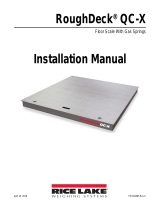
Junction Box and Grounding
© Rice Lake Weighing Systems ● All Rights Reserved 13
3.1 Load Cells to Junction Box
Each load cell is equipped with 30 ft of load cell cable, sufficient to reach a centrally-located junction box on standard scales. A
conduit adapter and a 14 in section of 3/4 in flexible conduit is supplied for both ends of each load cell cable located at the load
cell and at the junction box. The main conduit that runs between these 14 in flexible end sections are 3/4 in galvanized metal.
The conduit is already installed on the deck.
NOTE: Flexible conduit can not come in contact with the ground. Plastic tie wraps are included in the hardware shipping
box and should be used to tie up the flexible conduit.
If using a single B module, some of the conduit runs are not used. These conduit runs are used when more than one B
modules are installed.
3.2 Junction Box Connections
Each junction box is large enough to hold the summing board, transient protection devices, packaged desiccant and extra load
cell cable coiled inside the enclosure. An industrial corrosion inhibitor and desiccant such as the RLWS Industrial Corrosion
Inhibitor (PN 16037) should be added to the junction box enclosure before final closure.
NOTE: Summing card mounted within the junction box is used to make all cable terminal connections. All terminal pins are
clearly marked as to function.
3.3 Junction Box to Indicator
Fifty eight (58) feet of six-wire homerun cable is supplied for wiring the junction box to the indicator. It is run in 3/4 in galvanized
metal conduit from the junction box to the indicator. Conduit for this purpose is to be obtained locally. A 30 in flexible conduit
section and conduit connector is provided where this cable exits the junction box. Do not run any other electrical cables in or
near the conduit to the indicator.
3.4 Indicator to Peripherals
All 3/4 in conduit for cabling from the indicator to remote displays and other peripheral devices is to be obtained locally. Conduit
runs may be buried in a trench or secured above ground. Use separate conduit runs for AC power and DC data lines to avoid
interference. As a general guideline, run AC and DC cables in separate trenches if possible. If DC data cables must run in the
same trench as AC power lines, separate cables as much as possible (preferably more than 34 in apart).
3.5 Single-Point Ground Conductor
A bare 10 gauge solid wire is to be run from the scale frame to the grounding lug on the junction box then underground to the
main AC power earth ground. If the DC transient protection board is installed, the ground conductor should also be connected
to the transient protection board’s ground lug.
3.6 Electrical Ground Connections
IMPORTANT: A single-point grounding system is required. Improper grounding systems can cause corrupted data from
ground loop current flows and costly lightning damage to electronics.
Always strive for a single-point grounding system. Do not drive ground rods at the scale location which establishes separate
earth grounds for the scale. These separate earth grounds will not share the same zero reference as the existing earth ground
for the AC power system. This difference in electrical potential invites ground-loop current flow between the separate grounds,
often corrupting serial data like RS-232, which depends on a stable zero reference.
In addition, a separate earth ground system at the scale can actually invite lightning or power surge damage:
• A minor power line surge should immediately be shunted to ground. If a separate ground system exists at the scale with
a lower potential than the main ground, the surge may travel out to the scale ground rod, damaging load cells on its way.
• A nearby lightning ground strike may instantly raise the zero potential of a ground rod at the scale location, while leaving
the scale house ground rod unaffected. That lightning surge will now take the easiest path to the lower-potential
ground—through the scale wiring and back to the scale house ground, possibly damaging the indicator on its way.
Therefore, the best grounding system for the scale is the same grounding system used for the incoming AC power system. The
120 VAC power source used to power the indicator will be connected to an existing earth grounded rod system at the scale
house or other building where the indicator is located. This should consist of a double ground rod system of two 5/8 inx 8 ft
copper rods driven 8 ft deep at the service entrance where the local utility company brings their lines into the building.





















